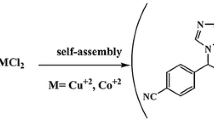Abstract
The competitive binding of anthracycline antitumour drugs, [daunomycin (DAU), doxorubicin (DOX) or nogalamycin (NOG)], with caffeine (CAF) to a model DNA oligomer has been investigated by 500 MHz 1H NMR spectroscopy under physiological solution conditions. The method depends on the stepwise analysis of one-component (self-association), two-component (hetero-association and DNA complexation) and three-component interactions, in order to de-convolute the overall binding of the anthracycline antibiotic and CAF to DNA into two competing processes, viz. hetero-association of the antibiotic-CAF (‘interceptor’ action of CAF) and CAF–DNA complexation (‘protector’ action of CAF). It is found that the complexation of DAU with DNA in the presence of CAF is mainly affected by the CAF–DNA complexation, whereas the binding of either DOX or NOG to DNA is affected approximately equally by both the CAF–DNA complexation and CAF-antibiotic hetero-association. Quantitative evaluation of the three-component mixture of drug–CAF–DNA has enabled the proportion of the antibiotic displaced from DNA on addition of CAF to be calculated over a large range of CAF concentration, which may provide a quantitative basis for the change in anthracycline-related toxicity on addition of CAF.






Similar content being viewed by others
References
Bedner E, Du L, Traganos F, Darzynkiewicz Z (2001) Caffeine dissociates complexes between DNA and intercalating dyes: application for bleaching fluorochrome-stained cells for their subsequent restaining and analysis by laser scanning cytometry. Cytometry 43:38–45
Chu E, DeVita VT (2003) Physicians’ cancer chemotherapy drug manual. Jones and Bartlett Publ, London
Davies DB, Djimant LN, Veselkov AN (1996) 1H NMR investigation of self-association of aromatic drug molecules in aqueous solution. J Chem Soc Faraday Trans 92:383–390
Davies DB, Eaton RJ, Baranovsky SF, Veselkov AN (2000) NMR investigation of the complexation of daunomycin with deoxytetranucleotides of different base sequence in aqueous solution. J Biomol Str Dyn 17:887–901
Davies DB, Veselkov DA, Djimant LN, Veselkov AN (2001) Hetero-association of caffeine and aromatic drugs and their competitive binding with a DNA oligomer. Eur Biophys J 30:354–366
Davies DB, Veselkov DA, Veselkov AN (2002) NMR determination of the hetero-association of phenanthridines with daunomycin and their competitive binding to a DNA oligomer. Eur Biophys J 31:153–162
Eaton RJ, Veselkov DA, Baranovsky SF, Osetrov SG, Djimant LN, Davies DB, Veselkov AN (2000) 1H-NMR studies of self-association of anthracycline antibiotic molecules in aqueous solution. Russ J Chem Phys 19:387–399
Evstigneev MP, Mykhina YuV, Davies DB (2005) Complexation of daunomycin with a DNA oligomer in the presence of an aromatic vitamin (B2) determined by NMR spectroscopy. Biophys Chem 118:118–127
Evstigneev MP, Khomich VV, Davies DB (2006a) Self-association of antibiotic daunomycin in various buffer solutions. Russ J Phys Chem 80:854–859
Evstigneev MP, Rybakova KA, Davies DB (2006b) Complexation of norfloxacin with DNA in the presence of caffeine. Biophys Chem 121:84–95
Gallois L, Fiallo M, Garnier-Suillerot A (1998) Comparison of the interaction of doxorubicin, daunorubicin, idarubicin and idarubicinol with large unilamellar vesicles: circular dichroism study. Biochim Biophys Acta 1370:31–40
Ibrahim MS (2001) Voltammetric studies of the interaction of nogalamycin antitumor drug with DNA. Anal Chim Acta 443:63–72
Larsen RW, Jasuja R, Hetzler R, Muraoka PT, Andrada VG, Jameson DM (1996) Spectroscopic and molecular modeling studies of caffeine complexes with DNA intercalators. Biophys J 70:443–452
Lyles MB, Cameron IL (2002a) Interactions of the DNA intercalator acridine orange, with itself, with caffeine, and with double-stranded DNA. Biophys Chem 96:53–76
Lyles MB, Cameron IL (2002b) Caffeine and other xanthines as cytochemical blockers and removers of heterocyclic DNA intercalators from chromatin. Cell Biol Int 26:145–154
Neidle S, Waring MJ (1983) Molecular aspects of anti-cancer drug action. Macmillan, London, p 483
Piosik J, Zdunek M, Kapuscinski J (2002) The modylation by xanthines of the DNA-damaging effect of polycyclic aromatic agents. Part II. The stacking complexes of caffeine with doxorubicin and mitoxantrone. Biochem Pharm 63:635–646
Piosik J, Ulanowska K, Gwizdek-Wisniewska A, Czyz A, Kapuscinski J, Wegrzyn G (2003) Alleviation of mutagenic effects of polycyclic aromatic agents (quinacrine mustard, ICR-191 and ICR-170) by caffeine and pentoxifylline. Mutat Res 530:47–57
Traganos F, Kapuscinski J, Darzynkiewicz Z (1991a) Caffeine modulates the effects of DNA-intercalating drug in vitro: a flow cytometric and spectrophotometric analysis of caffeine interaction with novatrone, doxorubicin, ellipticine and doxorubicin analogue AD198. Cancer Res 51:3682–3689
Traganos F, Kaminska-Eddy B, Darzynkiewicz Z (1991b) Caffeine reverses the cytotoxic and cell kinetic effects of novatrone (mitoxantrone). Cell Prolif 24:305–319
Ulanowska K, Piosik J, Gwizdek-Wisniewska A, Wegrzyn G (2005) Formation of stacking complexes between caffeine (1,2,3-trimethylxanthine) and 1-methyl-4-phenyl-1,2,3,6-tetrahydropyridine may attenuate biological effects of this neurotoxin. Bioorg Chem 33:402–413
Veselkov AN, Evstigneev MP, Veselkov DA, Davies DB (2001) A generalized NMR-derived statistical-thermodynamical model of hetero-association of aromatic molecules in aqueous solution. J Chem Phys 115:2252–2266
Acknowledgements
We thank the Royal Society for a NATO Fellowship (MPE).
Author information
Authors and Affiliations
Corresponding author
Rights and permissions
About this article
Cite this article
Evstigneev, M.P., Khomich, V.V. & Davies, D.B. Complexation of anthracycline drugs with DNA in the presence of caffeine. Eur Biophys J 36, 1–11 (2006). https://doi.org/10.1007/s00249-006-0071-9
Received:
Revised:
Accepted:
Published:
Issue Date:
DOI: https://doi.org/10.1007/s00249-006-0071-9




